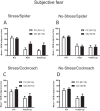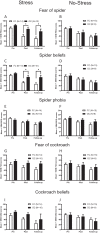Do oral contraceptives modulate the effects of stress induction on one-session exposure efficacy and generalization in women?
- PMID: 36894736
- PMCID: PMC10102109
- DOI: 10.1007/s00213-023-06345-3
Do oral contraceptives modulate the effects of stress induction on one-session exposure efficacy and generalization in women?
Abstract
Rationale: The administration of glucocorticoids (GC) as an adjunct to exposure represents a promising strategy to improve one-session exposure outcome in anxiety disorders. It remains to be determined whether similar effects can be induced with the use of acute stress. Furthermore, the possible modulation of exposure effects by hormonal factors (e.g., use of oral contraceptives (OCs)) was not explored so far.
Objectives: We investigated whether acute stress prior to one-session exposure for spider fear affects its efficacy in women using oral contraceptives (OC) relative to free-cycling (FC) women. In addition, effects of stress on generalization of exposure therapy effects towards untreated stimuli were examined.
Methods: Women with fears of spiders and cockroaches were randomly assigned to a Stress (n = 24) or No-Stress (n = 24) condition prior to one-session exposure. Of these 48 participants, 19 women used OC (n = 9 in the Stress, and n = 10 in the No-Stress group). All FC women had a regular menstrual cycle and were tested only in the follicular phase of their menstrual cycle. Pre-exposure stress induction was realized with the socially evaluated cold-pressor test. Exposure-induced changes towards treated and untreated fear stimuli were tested with behavioral approach tests for spiders and cockroaches and subjective fear and self-report measures.
Results: Acute stress did not influence exposure-induced reduction in fear and avoidance of the treated stimuli (spiders). Similarly, stress had no effect on the generalization of exposure-therapy effects towards untreated stimuli (cockroaches). Exposure-induced reduction in subjective fear and self-report measures for treated stimuli was less evident in women using OC specifically after pre-exposure stress. Women using OC had higher levels of subjective fear and scored higher in self-report measures at post-treatment (24 h after exposure) and follow-up (4 weeks after exposure).
Conclusions: OC intake may represent an important confounding factor in augmentation studies using stress or GC.
Keywords: Anxiety disorders; Cortisol; Glucocorticoids; Oral contraceptives; Single-session exposure; Spider fear; Stress.
© 2023. The Author(s).
Conflict of interest statement
None.
Figures




Similar articles
-
Generalization of Extinguished Fear to Untreated Fear Stimuli after Exposure.Neuropsychopharmacology. 2017 Dec;42(13):2545-2552. doi: 10.1038/npp.2017.119. Epub 2017 Jun 7. Neuropsychopharmacology. 2017. PMID: 28589965 Free PMC article. Clinical Trial.
-
No pills, more skills: The adverse effect of hormonal contraceptive use on exposure therapy benefit.J Psychiatr Res. 2019 Dec;119:95-101. doi: 10.1016/j.jpsychires.2019.09.016. Epub 2019 Sep 28. J Psychiatr Res. 2019. PMID: 31590077
-
The association between estradiol levels, hormonal contraceptive use, and responsiveness to one-session-treatment for spider phobia in women.Psychoneuroendocrinology. 2018 Apr;90:134-140. doi: 10.1016/j.psyneuen.2018.02.019. Epub 2018 Feb 21. Psychoneuroendocrinology. 2018. PMID: 29482136
-
Glucocorticoids enhance in vivo exposure-based therapy of spider phobia.Depress Anxiety. 2014 May;31(5):429-35. doi: 10.1002/da.22219. Epub 2013 Nov 21. Depress Anxiety. 2014. PMID: 24265104 Clinical Trial.
-
The effect of the phase of the menstrual cycle and the birth control pill on athletic performance.Clin Sports Med. 1994 Apr;13(2):419-41. Clin Sports Med. 1994. PMID: 8013042 Review.
Cited by
-
The impact of extinction timing on pre-extinction arousal and subsequent return of fear.Learn Mem. 2024 Apr 16;31(4):a053902. doi: 10.1101/lm.053902.123. Print 2024 Apr. Learn Mem. 2024. PMID: 38627067 Free PMC article.
-
How Different Factors in Combination Change Fear Extinction Learning: The Case of Sex and Stress Hormones.Curr Top Behav Neurosci. 2023;64:179-191. doi: 10.1007/7854_2023_427. Curr Top Behav Neurosci. 2023. PMID: 37455303
References
Publication types
MeSH terms
Substances
Grants and funding
- SFB 874 Project A1/Deutsche Forschungsgemeinschaft
- SFB 1280 Extinction Learning project SFB1280 - project number 316803389/Deutsche Forschungsgemeinschaft
- Project.A13 awarded to A.Z./Deutsche Forschungsgemeinschaft
- J.M./Deutsche Forschungsgemeinschaft
- project A09 to C.J.M./Deutsche Forschungsgemeinschaft
LinkOut - more resources
Full Text Sources
Medical
Miscellaneous

